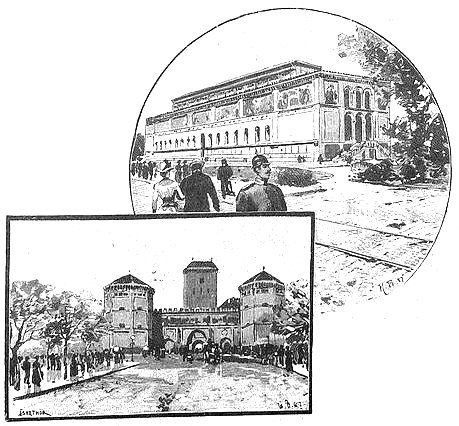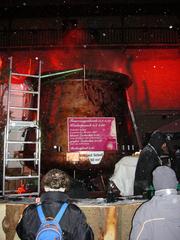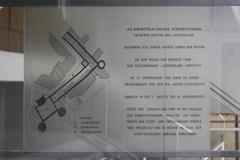
Comprehensive Guide to Visiting Isartor, Munich, Germany
Date: 18/07/2024
Introduction
Isartor, one of Munich’s most iconic landmarks, is a testament to the city’s rich historical and cultural heritage. Constructed in 1337 under Emperor Ludwig IV, also known as Ludwig the Bavarian, Isartor was a crucial part of Munich’s medieval fortifications. The gate, named after the nearby Isar River, not only served as a defensive structure but also became a symbol of the city’s growth and prosperity (Munich Tourist Information).
The architectural beauty of Isartor, characterized by its Gothic design and central tower flanked by two smaller towers, reflects the medieval military architecture of the time. Over the centuries, Isartor has undergone several restorations, most notably in the 19th century by Friedrich von Gärtner, to preserve its historical integrity and Gothic features (Bavarian State Department of Monuments and Sites).
Today, Isartor is more than just a historical monument. It houses the Valentin-Karlstadt-Musäum, dedicated to Bavarian comedians Karl Valentin and Liesl Karlstadt, offering a unique glimpse into Munich’s cultural history (Valentin-Karlstadt-Musäum). With its central location in Munich’s Altstadt, Isartor is easily accessible and serves as a starting point for many visitors exploring the city’s rich history and vibrant culture.
Table of Contents
- Introduction
- Historical Background
- Restoration and Preservation
- Cultural and Social Impact
- Visiting Isartor
- Notable Events and Anecdotes
- Tourist Attraction
- Educational Value
- Community Engagement
- Preservation Efforts
- Economic Impact
- Future Prospects
- FAQ
- Conclusion
Historical Background
Origins and Construction
Isartor, a historical city gate, dates back to the 14th century. Constructed in 1337 under the reign of Emperor Ludwig IV, Isartor was part of the second city wall expansion aimed at fortifying Munich against potential invasions. The gate was named after the nearby Isar River, which played a crucial role in the city’s trade and defense strategies.
Architectural Features
Isartor is a prime example of medieval military architecture. It features a central tower flanked by two smaller side towers, all connected by a fortified wall. The central tower, standing at approximately 40 meters, served as a lookout point and a defensive stronghold. The gate’s design includes a pointed archway, typical of Gothic architecture, which allowed for the passage of both pedestrians and horse-drawn carriages.
Historical Significance
Isartor holds significant historical value as it represents Munich’s medieval past and its strategic importance in the Holy Roman Empire. The gate was not only a defensive structure but also a symbol of the city’s growth and prosperity. During the Middle Ages, Munich was a bustling trade hub, and Isartor was one of the main entry points for merchants and travelers.
Restoration and Preservation
Over the centuries, Isartor has undergone several restorations to preserve its historical integrity. The most notable restoration took place in the 19th century under the direction of Friedrich von Gärtner, a renowned German architect. Gärtner’s work focused on restoring the gate’s original Gothic features while incorporating elements of the Neo-Gothic style. In the aftermath of World War II, Isartor suffered significant damage but was meticulously restored to its former glory.
Cultural and Social Impact
Isartor has played a vital role in Munich’s cultural and social life. In the 19th century, the gate became a popular meeting point for locals and a venue for public events. Today, it houses the Valentin-Karlstadt-Musäum, dedicated to the famous Bavarian comedian Karl Valentin and his partner Liesl Karlstadt. The museum offers a unique glimpse into Munich’s cultural history and the lives of two of its most beloved entertainers.
Visiting Isartor
Ticket Prices and Opening Hours
Isartor is accessible to visitors, with the Valentin-Karlstadt-Musäum open daily from 11 AM to 6 PM. Admission prices are as follows: adults €2.99, children under 12 €1.99, and group discounts are available.
Travel Tips and Accessibility
Isartor is located in the heart of Munich’s Altstadt (Old Town), within walking distance from Marienplatz, the city’s central square. It is well-connected by public transportation, including the S-Bahn and U-Bahn systems. The site is wheelchair accessible, and guided tours are available for those interested in learning more about its history and significance.
Notable Events and Anecdotes
Throughout its history, Isartor has been the backdrop for numerous notable events and anecdotes. One such event is the annual celebration of Fasching, Munich’s carnival season, which includes parades and festivities around the Isartor area.
Tourist Attraction
Isartor is a major tourist attraction, drawing visitors globally. Its central location makes it easily accessible, and it serves as a starting point for many walking tours of Munich’s historic center. The gate’s picturesque appearance and historical significance make it a popular spot for photography and sightseeing. Nearby Isartorplatz is a bustling area filled with cafes, shops, and restaurants, offering a vibrant street life experience (Munich Travel Guide).
Educational Value
Isartor serves an educational purpose. Schools and universities often organize field trips to the gate, where students learn about Munich’s medieval history, architecture, and cultural evolution. The Valentin-Karlstadt-Musäum offers educational programs and workshops, making it a valuable resource for learning about Bavarian culture and history (Munich Education Department).
Community Engagement
Isartor is a vital part of community engagement. It hosts various cultural events, including art exhibitions, music performances, and historical reenactments, fostering a sense of community and providing a platform for local artists and performers. The Valentin-Karlstadt-Musäum also organizes special events and temporary exhibitions, attracting a diverse audience and promoting cultural exchange (Munich Cultural Department).
Preservation Efforts
Preserving Isartor is a priority for Munich. Ongoing maintenance and restoration work ensure that the gate remains in good condition for future generations. The Bavarian State Department of Monuments and Sites oversees these efforts, employing experts in historical preservation and architecture. Public awareness campaigns and fundraising initiatives also support the preservation of Isartor, highlighting its importance to Munich’s cultural and historical landscape (Bavarian State Department of Monuments and Sites).
Economic Impact
Isartor contributes to Munich’s economy by attracting tourists and supporting local businesses. The influx of visitors generates revenue for the city’s hospitality and retail sectors. Additionally, the Valentin-Karlstadt-Musäum and other cultural institutions around Isartor create jobs and stimulate economic activity. The gate’s significance underscores the importance of cultural heritage in driving economic growth and development (Munich Economic Department).
Future Prospects
Looking ahead, Isartor will continue to be a focal point of Munich’s historical and cultural identity. Plans for future development include enhancing visitor facilities, expanding educational programs, and increasing community engagement. These initiatives aim to ensure that Isartor remains a vibrant and relevant part of Munich’s urban landscape, celebrating its past while looking toward the future (Munich Urban Development Department).
FAQ
Q: What are the visiting hours for Isartor? A: The Valentin-Karlstadt-Musäum, located within Isartor, is generally open from 11:00 AM to 6:00 PM. Hours may vary on holidays and special occasions.
Q: How much are the tickets to visit Isartor? A: Ticket prices for the Valentin-Karlstadt-Musäum are reasonably priced, with special rates for students and seniors. It’s best to check the official website for the most current prices.
Q: Are there any guided tours available at Isartor? A: Yes, guided tours and special events are frequently hosted at Isartor. Visit the official website for detailed information.
Conclusion
Isartor remains a multifaceted landmark with profound historical, architectural, cultural, and economic significance. Its preservation and continued relevance are testaments to Munich’s dedication to honoring its heritage while embracing modernity. The gate not only attracts tourists and supports local businesses but also serves as an educational resource and a hub for community engagement through various cultural events and exhibitions (Munich Cultural Department).
Looking ahead, Isartor will continue to be a focal point of Munich’s historical and cultural identity, with plans to enhance visitor facilities, expand educational programs, and increase community engagement. These initiatives aim to ensure that Isartor remains a vibrant and relevant part of Munich’s urban landscape, celebrating its past while looking toward the future (Munich Urban Development Department). Whether you are a history enthusiast, a cultural explorer, or a casual visitor, Isartor offers a rich and engaging experience that highlights Munich’s medieval past and its ongoing journey through time.
References
- Munich Tourist Information. Retrieved from https://www.muenchen.de/sehenswuerdigkeiten/orte/120345.html
- Bavarian State Department of Monuments and Sites. Retrieved from https://www.blfd.bayern.de
- Valentin-Karlstadt-Musäum. Retrieved from https://www.valentin-musaeum.de
- Munich Cultural Department. Retrieved from https://www.muenchen.de/rathaus/Stadtverwaltung/Kulturreferat.html
- Munich Urban Development Department. Retrieved from https://www.muenchen.de/rathaus/Stadtverwaltung/Referat-fuer-Stadtplanung-und-Bauordnung.html






































































































